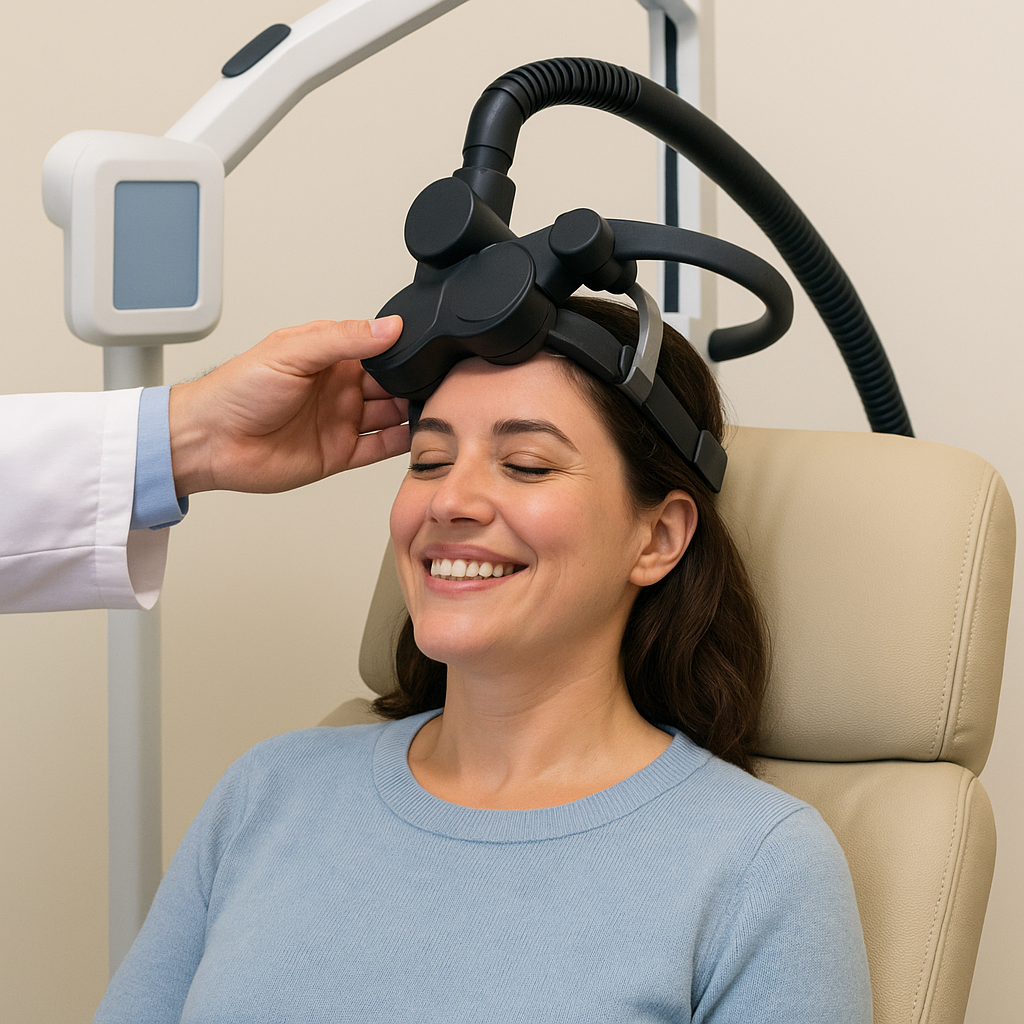Not TMZ… TMS: A Pulsating New Way to Treat Depression?
After months of stalled progress, my therapist pushed me to try something new: Transcranial Magnetic Stimulation. But I’m still not sure I’m ready.

I’ve always tried to face my mental health struggles head-on, but lately, the tools in my belt—therapy, medication, writing—haven’t been enough.
A few months ago, my therapist – who I've referred to as "Dr. Mike" in my previous articles --suggested something new: Transcranial Magnetic Stimulation, or TMS.
I’ll be honest—I didn’t even know what that was at first. My first reaction was, TMZ? The gossip site?
Dr. Mike must have noticed the quizzical look on my face. He went on to explain the process. As soon as he started by saying technicians strap a contraption around the patient's head, I got visions of Jack Nicholson in One Flew Over the Cuckoo's Nest.

I immediately interrupted, "Whoa! Whoa! Whoa! Are we talking electrolysis here?"
Dr. Mike shook his vehemently, "No. No. No. It's not like that."
I bit my tongue – no pun included – and listened to his explanation.
TMS is a non-invasive treatment that uses magnetic pulses to stimulate parts of the brain that may be underactive in people with depression—particularly the prefrontal cortex, which plays a big role in mood regulation.
It’s not shock therapy, and it doesn’t involve medication. You stay fully awake the entire time. During each session, you sit in a chair while a coil is placed gently against your scalp. The coil sends quick, repetitive pulses to very specific areas of the brain. The idea is to “wake up” the regions that aren’t firing the way they should.
Each session lasts about 20 to 40 minutes, and the full treatment usually involves going five days a week for four to six weeks. It’s FDA-approved, and while it sounds a little like something out of One Flew Over The Cuckoo's Nest, it has helped a lot of people who haven’t found relief elsewhere.
I left the session that day feeling conflicted. On one hand, the science behind it made sense—and after years of trying every standard approach, maybe it was time to think outside the box. On the other hand, the idea of strapping into a machine that zaps my brain (even gently) didn't sit well with me.
For someone with social anxiety like me, the idea of going to Butler Hospital—the mental health facility that would administer the procedure—and interacting with someone five days a week for several weeks seemed unappealing. And for someone who never knows from day to day how I’m going to feel, the time commitment felt daunting.
Today, I had my monthly appointment with Dr. Mike. He seemed less cordial than usual – almost impatient.
Mind you, every appointment I’ve had with him since that first visit where he introduced TMS, he’s pressed me on why I haven’t gone ahead and scheduled it. I’ve probably had six or seven visits since then. And every time, I express the same concerns—my social anxiety, my unpredictable energy, and my fear of committing to something so structured and long-term.
So when I began this appointment venting about the latest setback in my Social Security disability case, I could tell he wasn’t interested. After listening to my ten-minute monologue, he cut in bluntly: “So what about TMS?”
"Haven't you seen the news. The employees at Butler have been on strike for the last three weeks. I drove by there the other day – they're picketing and blocking the roadway to the facility."
I wasn't lying.
"Tony, come on."
He wasn’t having it. I couldn’t help but be surprised by his demeanor. He’s never been the warm-and-fuzzy type, but today he seemed borderline confrontational—unbecoming of a therapist.
"What are we doing here?" he asked, his eyes burrowing into me.
My mindset shifted on the spot. This wasn’t going to be a soothing, talk-it-out kind of session. It was now adversarial. I was on the defensive.

“Every visit for the last six months has been the same thing,” he said, leaning forward, chin nearly touching the top of his laptop screen. “We’re not accomplishing anything. You’re not getting any better. I wouldn’t be doing my job if I didn’t try something different.”
I diverted my gaze, staring out the window. How many minutes are left in this session? I tried to sneak a glance at the digital clock nearby.
Fortunately, these awkward sessions are only twenty minutes. I found that odd when I first started seeing him—until I realized his job wasn’t to be a therapist. He was there to monitor my medications. That’s all he really cared about. Not my stories, not my struggles—just whether the pills were working. And if they weren’t, it was his job to suggest other methods.
“There are other prescriptions we can try,” he said. “You’ve been on five different meds, and nothing has seemed to help. There are still plenty of other SSRIs or combinations we can go with.”
“Yeah, I haven’t felt any different on any of them—except for Abilify. And that was only because it made me feel like crap: faint, lightheaded, fatigued.”
“Tony, that was 2023,” he replied, glancing at his screen. “We haven’t made any changes since then. I’m not trying to be a jerk, but if you keep putting off the TMS, then we’re not doing anything new. And I wouldn’t be doing my job if we didn’t try something.”
There was that tone again. I stared at my foot, now tapping involuntarily on the floor.
“Well, let’s try another medication then,” I said. I knew that wasn’t the answer he wanted. He wanted me to do the TMS.
"I don't understand why you won't just do the TMS," he said. "Why would you not want to do something that has a better than 50/50 shot at helping you get better?"
And here's the thing – he's right. Studies have shown that TMS works for over half the people who try it—and about a third go into full remission. That’s better odds than any antidepressant I’ve ever been prescribed. So why am I so hesitant?
Maybe it’s pride. Maybe it’s fear. Maybe it’s the quiet dread that if this doesn’t work, then what’s left?
I don’t know yet if I’ll do the TMS. But I know I’m not the only one who feels caught between the familiar misery of what’s not working and the uncertain hope of something new. I know that decisions like these don’t get made in one session, or even six.
I just know that today, I left that room feeling like a problem to be solved, not a person being heard. And maybe that’s what hurts most.
If you’ve tried TMS—or are thinking about it—I’d love to hear your story. Sometimes the most healing thing isn’t a pill or a machine. It’s talking about things out in the open and being there for each other.
📣 Enjoyed this article? Share it:
🐦 Share on Twitter/X
📘 Share on Facebook
💼 Share on LinkedIn
✉️ Share via Email
